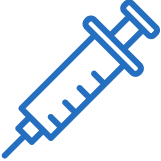Over 4.2 million people in South Africa have diabetes, and for those with type 1 diabetes, their bodies cannot produce insulin naturally to regulate blood sugar levels. Similarly, individuals with type 2 diabetes either struggle to use insulin efficiently or don't produce enough of it. In the United States alone, nearly 4.2 million people with diabetes require insulin to manage their blood sugar levels.
Insulin can be administered through various methods, such as syringes, pens, or pumps. Your doctor will guide you in choosing the most suitable option based on factors like insulin dosage, comfort, and cost considerations. Whether you're new to self-administering insulin injections or it has become a daily routine, it's crucial to consider the size of the syringe and needle to ensure consistent blood sugar control.
This article aims to provide essential information about Econocare insulin syringes that you should know.
Understanding Econocare Insulin Syringes
When purchasing Econocare insulin syringes, there are a few key points to consider. These syringes are disposable and designed for single-use to maintain sterility and eliminate the risk of infections associated with reused needles. It is also important to rotate injection sites regularly to prevent the development of lipohypertrophy, an abnormal fat deposit under the skin that can occur with frequent insulin injections.
Insulin is typically administered as a subcutaneous injection, just beneath the skin, to avoid affecting blood sugar levels by penetrating the muscles. The appropriate syringe size depends on your insulin dosage, as it may fluctuate based on your blood sugar levels. Therefore, you may need multiple syringe sizes to accommodate necessary dose adjustments.
Insulin needles are available in various sizes and thicknesses. The sizes of Econocare insulin syringes correspond to the following measurements:
- 0.3 mL syringes are suitable for insulin doses under 30 units and are marked at 1/2-unit or 1-unit intervals.
- 0.5 mL syringes are designed for 30 to 50 units of insulin and are marked at 1-unit intervals.
- 1.0 mL syringes are appropriate for doses exceeding 50 units of insulin and are marked at 2-unit intervals.
Determining the Correct Size for Your Econocare Insulin Syringe
Choosing the correct size of an Econocare insulin syringe involves considering your insulin dosage and your comfort level with the needle size. Selecting the appropriate size ensures that you can administer the full insulin dose accurately and avoid dosing errors resulting from using the wrong syringe.
If you require different insulin doses throughout the day, it may be necessary to have multiple syringes. For example, if you take 35 units in the morning and 10 units at night, you would need a 0.3 mL syringe for the morning dose and a 0.5 mL syringe for the evening dose. Syringes also provide flexibility for adjusting doses daily based on blood sugar levels.
If your insulin dose is close to the maximum capacity of the syringe, it is advisable to choose a larger size to facilitate proper handling.









